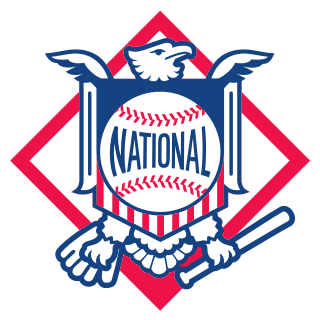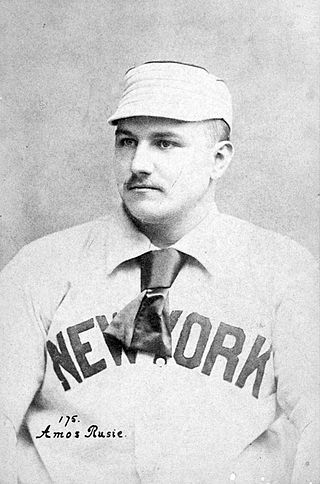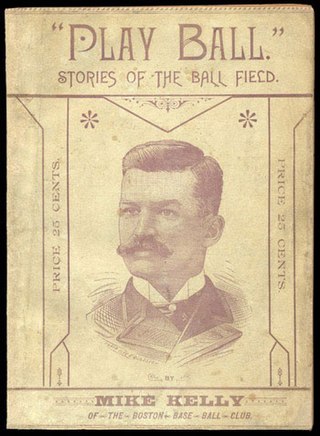
The history of baseball in the United States dates to the 18th century, when boys and amateur enthusiasts played a baseball-like game by their own informal rules using homemade equipment. The popularity of the sport grew and amateur men's ball clubs were formed in the 1830–50s. Semi-professional baseball clubs followed in the 1860s, and the first professional leagues arrived in the post-American Civil War 1870s.

The National League of Professional Baseball Clubs, known simply as the National League (NL), is the older of two leagues constituting Major League Baseball (MLB) in the United States and Canada, and the world's oldest extant professional team sports league. Founded on February 2, 1876, to replace the National Association of Professional Base Ball Players (NAPBBP) of 1871–1875, the NL is sometimes called the Senior Circuit, in contrast to MLB's other league, the American League, which was founded 25 years later and is called the "Junior Circuit". Both leagues currently have 15 teams.

The Major League Baseball Players Association (MLBPA) is the labor union representing all current Major League Baseball players. All players, managers, coaches, and athletic trainers who hold or have held a signed contract with a Major League club are eligible for membership in the Association.
The reserve clause, in North American professional sports, was part of a player contract which stated that the rights to players were retained by the team upon the contract's expiration. Players under these contracts were not free to enter into another contract with another team. Once signed to a contract, players could, at the team's whim, be reassigned, traded, sold, or released.

Amos Wilson Rusie, nicknamed "The Hoosier Thunderbolt", was an American right-handed pitcher in Major League Baseball during the late 19th century. He had a 10-season career in the National League (NL), which consisted of one season with the Indianapolis Hoosiers in 1889, eight with the New York Giants from 1890 to 1898, and one with the Cincinnati Reds in 1901.

The Philadelphia Athletics were a professional baseball team, one of six charter members of the American Association, a 19th-century major league, which began play in 1882 as a rival to the National League. The other teams were the Baltimore Orioles, Cincinnati Red Stockings, Eclipse of Louisville, Pittsburgh Alleghenys, and St. Louis Brown Stockings. The team took its name from a previous team, which played in the National Association from 1871 through 1875 and in the National League in 1876.

Arthur H. Soden was an American executive in Major League Baseball who was the president/owner of the Boston Base Ball Club of the National League during the 1887–1906 seasons, president of the National League in 1882, and a Civil War veteran.

John Elmer Stivetts was a professional baseball pitcher who played 11 seasons in Major League Baseball (MLB) spanning from 1889 to 1899. He played in the American Association (AA) with the St. Louis Browns, and in the National League (NL) with the Boston Beaneaters and Cleveland Spiders. "Happy Jack" was born to German immigrants and raised in Ashland, Pennsylvania. He initially followed his father into the coal mining industry before playing professional baseball. After playing two and half seasons in minor league baseball, he was signed by the Browns. Over the next few seasons, he was regarded as one of the best pitchers in baseball.
The following are the baseball events of the year 1882 throughout the world.

Marcus Elmore Baldwin, nicknamed "Fido" and "Baldy", was an American right-handed professional baseball pitcher who played seven seasons in Major League Baseball (MLB). In 346 career games, he pitched to a 154–165 win–loss record with 295 complete games. Baldwin set the single-season MLB wild pitches record with 83 that still stands today.
The following are the baseball events of the year 1890 throughout the world.
The following are the baseball events of the year 1889 throughout the world.
The following are the baseball events of the year 1887 throughout the world.
The Pittsburgh Burghers were a baseball team in the Players' League, a short-lived Major League that existed only for the 1890 season. The team included a number of players who had jumped from the National League's Pittsburgh Alleghenys, including Hall of Famers Pud Galvin, Ned Hanlon, and Jake Beckley. Hanlon served as the team's manager. Meanwhile, John Tener, who would go on to represent Pittsburgh in the United States Congress and be elected the 25th Governor of Pennsylvania, finished his pitching career with the Burghers in 1890. Later Tener would become the president of the National League, and a director of the Philadelphia Phillies.
The Philadelphia Athletics were a short-lived Major League Baseball franchise that existed for two seasons from 1890 to 1891. Known alternatively as the Philadelphia Quakers, and sometimes informally as "Buffinton's Beauties", they played their first season in the newly created Players' League (PL) of 1890, and were managed by Jim Fogarty and Charlie Buffinton. After the demise of the PL following the 1890 season, the team switched to the American Association (AA) for the 1891 season, and were managed by Bill Sharsig and George Wood. For each season, the franchise used Forepaugh Park as their home field.

George Edward Andrews was an American professional baseball player. He was a right-handed second baseman and outfielder over parts of eight seasons (1884–1891) with the Philadelphia Quakers, Indianapolis Hoosiers, Brooklyn Ward's Wonders and Cincinnati Kelly's Killers. He was the National League stolen base champion in 1886 with Philadelphia. For his career, he compiled a .257 batting average, with 278 RBIs, 602 runs scored, and 205 stolen bases.
The 1889 Louisville Colonels season was a season in American baseball. The team finished with a 27–111 record, last in the American Association.

The Boston Reds were a Major League Baseball franchise that played in the Players' League (PL) in 1890, and one season in the American Association (AA) in 1891. In both seasons, the Reds were their league's champion, making them the second team to win back-to-back championships in two different leagues. The first franchise to accomplish this feat was the Brooklyn Bridegrooms, who won the AA championship in 1889 and the National League (NL) championship in 1890. The Reds played their home games at the Congress Street Grounds.

Play Ball: Stories of the Ball Field is an 1888 autobiographical collection of baseball stories from Major League Baseball player King Kelly. Kelly had come to Boston one year earlier to play for the Boston Beaneaters. The book was organized and put together by Boston Globe journalist John J. "Jack" Drohan.

John Montgomery Ward, known as Monte Ward, was an American Major League Baseball pitcher, shortstop, second baseman, third baseman, manager, executive, union organizer, owner and author. Ward, of English descent, was born in Bellefonte, Pennsylvania and grew up in Renovo, Pennsylvania. He led the formation of the first professional sports players union and a new baseball league, the Players' League.











